I recently felt like my elbow was struggling to swing my heavier racket, so I had to bite the bullet and get myself a new one as having a problem-free elbow is priceless. Getting the best badminton racket for intermediate players is not exactly a breeze, though.
It’s nearly impossible to play-test a racket before buying it unless we are lucky enough to find a friend with that exact model who is willing to lend it to us. If not, we’re buying blindly and hoping for the best.
Sure, online reviews like these can be useful but they do a better job of creating a shortlist to dive deeper with than helping us settle on the perfect racket.
After my own frustration with this experience as a player, I dream of opening test centers worldwide so every badminton player can try out rackets before buying them… but that’ll stay a dream for now.
Just like it’s extra tricky for us intermediate players to find the right match-up with opponents that aren’t too advanced or inexperienced, we have the same problem when it comes to finding the perfect racket.
If you’re a pro or a beginner there are certain ranges that just don’t fit for whatever reason. At the intermediate level, it’s murkier…
At the upper-intermediate level, we tend to be more focused and aware of our playing style and preferences. But at the lower intermediate and mid-intermediate levels, we might not be too confident in our playing style, strengths, and weaknesses just yet.
If that’s you, you’ll likely benefit from a racket that helps with many facets of the game and is playable on off-days when you aren’t bringing your A-game. If you play doubles, like many other casual players in this category, you’ll need to cover both the front-court, rear-court and be able to play a variety of shots reasonably well.
Middle of the road-rackets fit this description the best as they sacrifice some raw smash power or speed in exchange for a more balanced game overall. Choosing that style of racket removes most choices and allows you to focus on just two things: how flexible you prefer your racket to be and what your budget is.
There are general rules of thumb when it comes to flexibility but it comes down to your preference as each brand does it slightly differently. It can be a clue that your racket is too flexible if you mistime easy shots you normally wouldn’t when you’re not under pressure.
In this mini-guide, I’ve broken the intermediate player category up into several subcategories.
Most noticeably, my favorite choice for players considering themselves at the low-intermediate level. Beyond that, I’ll offer suggestions on rackets based on power and speed, if you already know your general preferences.
While I’m constantly play-testing and reviewing rackets just for intermediate players like myself, I haven’t been through all the rackets out there, so take this with a grain of salt.
I figure you’ll prefer to see some of the best badminton rackets for intermediate players right away, so let’s dive right in rather than cover the methodology first.
Towards the end of this article, I’ll share pointers on how to judge if you’re an intermediate badminton player and how I selected these rackets.
Let’s look at an overview of the rackets next.
The best badminton racket for intermediate players – my 3 top picks
Hey reader, a quick interruption... I’m experimenting partnering with webshops that sell badminton gear, like Amazon. I’ll include links to buy the gear I review and if you do, they’ll pay me a small commission. That doesn’t change your price and you’ll get more play-tested gear as a result but I thought it was fair to let you know. As an Amazon Associate, I earn from qualifying purchases. I appreciate your support, Aske
1. Best for low-intermediate players: Yonex Arcsaber 11 Play
2. Best racket for power-loving intermediate players: Yonex Astrox 100 Game
3. Best racket for defense-loving intermediate players: Yonex Nanoflare 1000 Game
Table of Contents
- The best badminton racket for intermediate players – my 3 top picks
- Finding intermediate badminton rackets by playing style
- The best badminton rackets for intermediate players
- Summary of your intermediate player rackets
- Methodology: how I selected the best rackets for you
- An example of the fabric of intermediate players
Finding intermediate badminton rackets by playing style
I’ve put together a racket matrix estimating how the rackets compare to each other based on power and control. You’ll be able to find the details in the methodology section at the bottom of this guide.
Here’s how different intermediate-level playing styles add up on the racket matrix.

Here are the rackets mapped out on the matrix. It’s difficult to get 100% accuracy, especially when comparing different brands, so take this with a grain of salt.
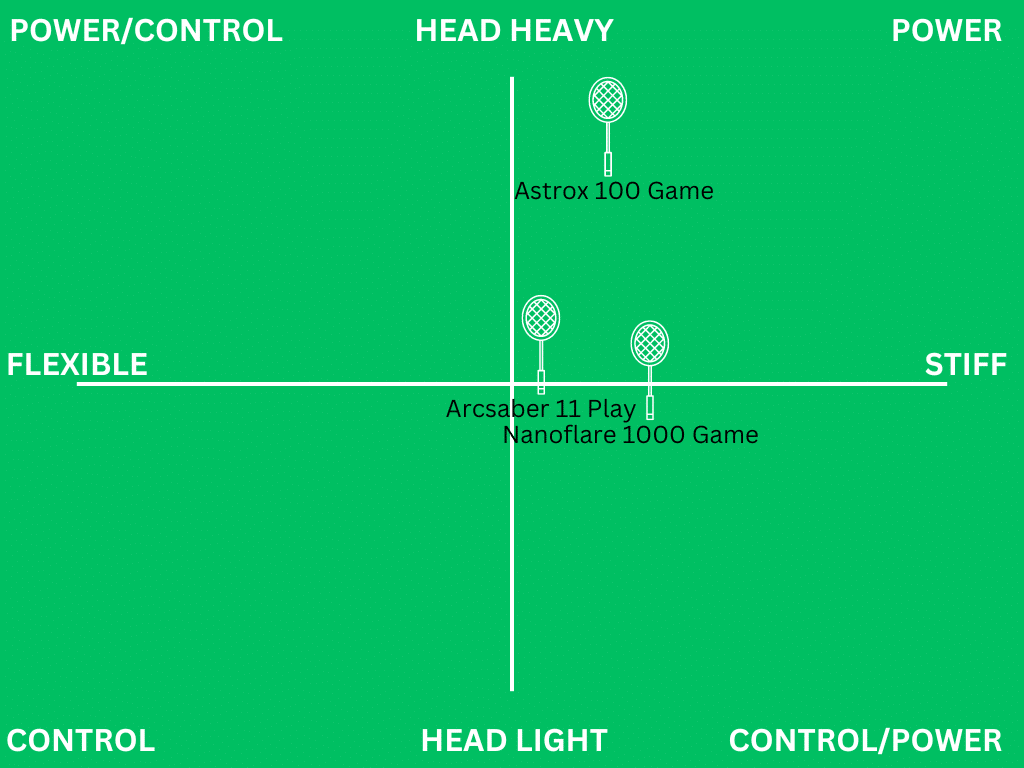
The best badminton rackets for intermediate players
Best for low-intermediate players – Yonex Arcsaber 11 Play

Pros
- A larger sweet spot makes it easier to hit a good shot
- Nice feeling when you hit the shuttle offering more control
- Good all-around with no clear weaknesses
Cons
- It may feel difficult to generate raw smash power if you haven’t trained it
- Not the most supportive racket if you have a pronounced playing style and love playing a single specific shot
The Arcsaber 11 Play from Yonex is a great option for anyone who doesn’t have a pronounced playing style.
You might think that sounds bland. However, it’s an evenly balanced racket that is a relying weapon when you fight out close and tense net battles, while still being able to swing enough attacking power to put pressure on your opponent.
It falls right in the middle on the flexibility scale and offers good accuracy in your shots while lower intermediate players will still be able to generate fast shuttles even if they don’t have the sharpest technique and stroking power.
It also features a square/isometric head shape. Not because one of the engineers shat the bed, or because they let everyone in the design department run wild.
Most newer Yonex badminton rackets have started leaning towards this design over the round/egg shape, as it provides a larger “sweet-spot” area which means you’ll have a little extra help in hitting the shuttle right where it hurts.
I recently play-tested this racket and loved it.
Key Specs
- Weight Class & Grip Size: 4U, G5
- Balance Point: Even balance
- Flexibility: Medium
Best racket for power-loving intermediate players: Yonex Astrox 100 Game
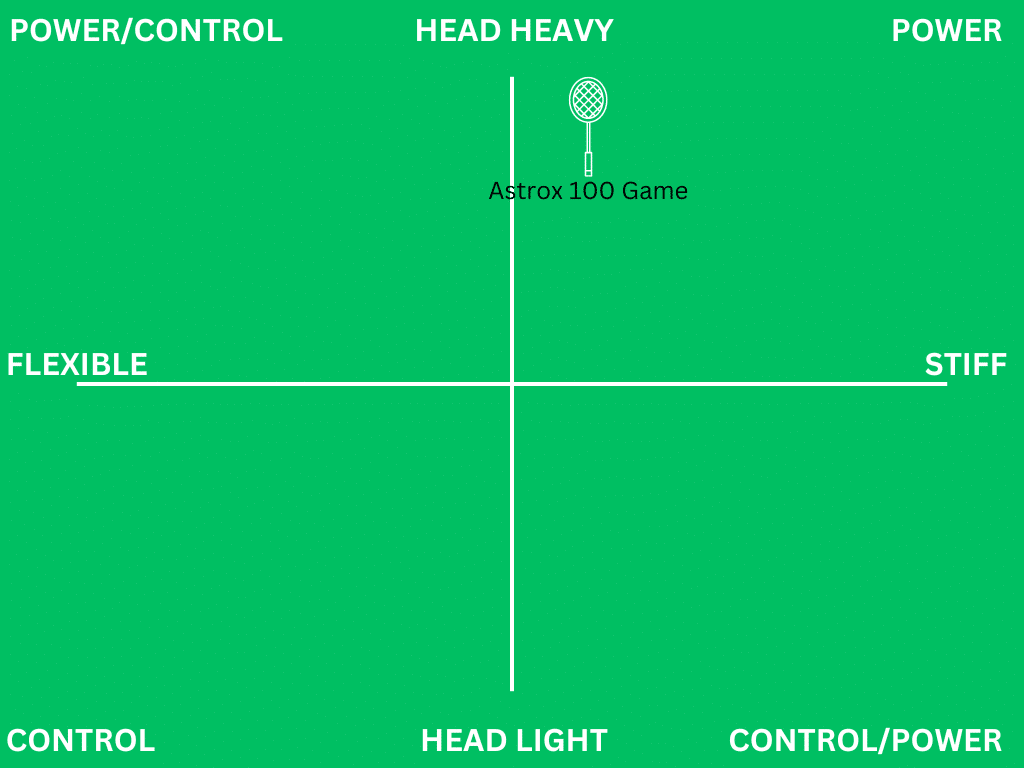
Pros
- Easy power, especially if you’re late or your technique isn’t amazing
- Blocks are a joy due to pretty fast swing speed for a head heavy racket
- Flat drive exchanges in doubles were easy to control and put power behind
Cons
- Difficult to be precise with tight net play
Next, let’s look at rackets for the common intermediate player. Instead of more all-around rackets, I’ve divided this up into rackets prone to speed or power as these two player styles are the most common and selected two from each category.
With more experience, you’re likely also more in tune with the nuances of the game and especially the nuances of your own game. You’ll have a better understanding of your strengths and weaknesses, which ones you’d like to practice more, and which ones you’d like your racket to help you with.
The Yonex Astrox 100 Game is the less beasty version of Viktor Axelsen’s racket, that we mere mortals can tame. The other editions, the Astrox 100ZZ, 100 Tour, and 100ZX are all extra stiff meaning that they require extra good technique.
When I play-tested this racket, I found that it was a true powerhouse, as one would expect from the most head-heavy racket for intermediate players in Yonex’s repertoire. Other players even commented on the power I was able to generate (and my badminton smash technique isn’t that good)
This racket was a lot of fun to play with for someone like me who is an intermediate player and doesn’t have crazy good stamina. I was often able to get shots back over the net without problems even if I was late. It swung pretty fast considering how head-heavy it is and made flat drive duels a decent experience.
On the other hand, tight and precise net shots were challenging to control. My experience playing with this racket was that it was more about controlling the power (and the urge to hit at full power) rather than attempting to extract the power from it.
Here’s my detailed review of the Yonex Astrox 100 Game.
Key Specs
- Weight Class & Grip Size: 4U/G5/G6, 3U/G4/G5/G6
- Balance Point: Head heavy
- Flexibility: Medium
Best racket for defense-loving intermediate players: Yonex Nanoflare 1000 Game
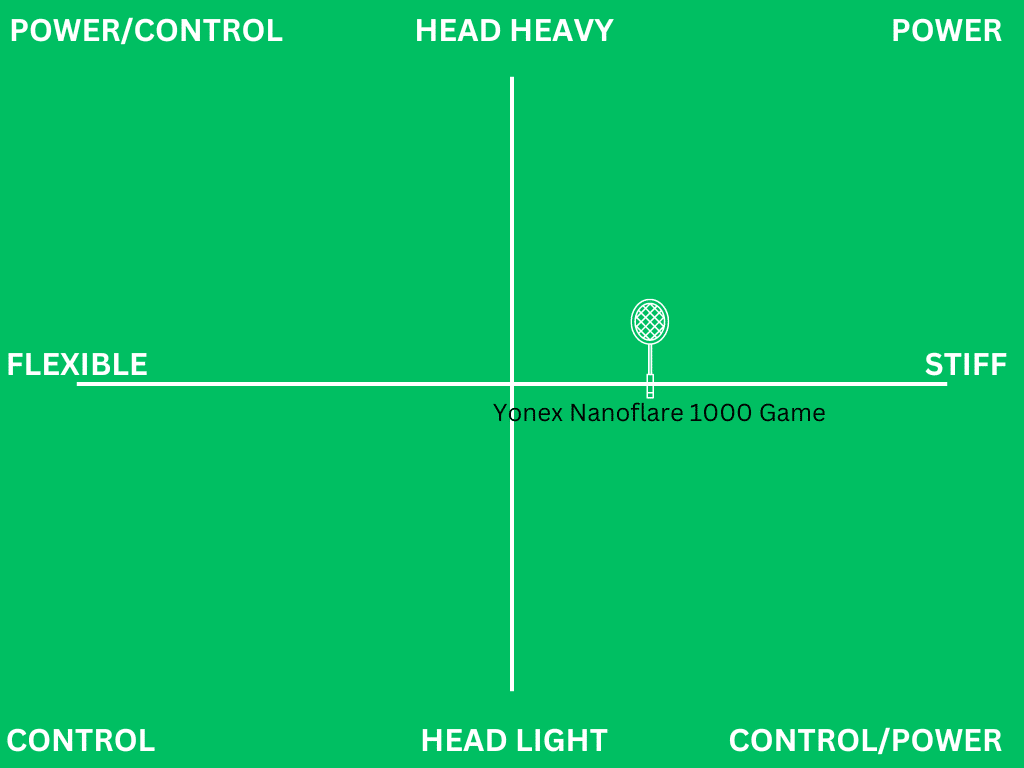
Pros
- Fast swings and changing grip in defense is amazing
- Generating power is easier than expected but challenging under pressure if you’re used to a head heavy racket
Cons
- The extra control you get on smash blocks takes a while to get used to as you can’t just put the racket on the shuttle to return it as easily
- The Game-model is only sold in the 4U weight class at the moment, so it’s unlikely you’ll like it for singles games
I’ve always hesitated to play with fast head light rackets as they usually come at the expense of raw power. With a technique that isn’t exactly amazing and little spare time to improve it, I’ve been putting off testing Yonex’s recent release, the Nanoflare 1000 Game.
It is intended as the intermediate model of their Nanoflare 1000Z that took the record for the fastest smash.
After testing it I have to admit that I’m pleasantly surprised and I might switch to this racket for the foreseeable future.
It felt difficult to generate power smashes at the rear court when I was under pressure, but given plenty of time it was easier than expected. That’s not to say it was easier, and definitely not as easy as with a head heavy racket, but my expectations were that powerful smashes wouldn’t be possible at all. That wasn’t the case.
Stick smashes with less power and more precision felt good and clear shots were surprisingly easy.
But where this racket really shines is in counter-attacking and sending shots back over the net. I continue to find myself getting shots back that I normally wouldn’t with heavier rackets as it maneuvers so quickly through the air.
I especially noticed it when attacks came flying back at me one after the other and I had to quickly switch grip in between.
This is a weird experience at first (but epically awesome!)
If you’re an intermediate player who is used to smashing a lot, you’ll have to change your playing style or practice your smash skills to enjoy playing with this racket. If you’re playing doubles, I bet changing your playing style will be more fun in the long run if you’re looking to improve, even if it takes a little while to get used to.
You can read my in-depth test review here.
Key Specs
- Weight Class & Grip Size: 4U/G5/G6
- Balance Point: Head light
- Flexibility: Medium
Summary of your intermediate player rackets

When it comes to the best badminton racket for intermediate players, even if you’re a lower-intermediate player, there’s good reason to start moving away from assistance with power you’ll often get with flexible rackets and bring more control into the mix.
That being said, brands constantly launch new wacky designs and racket technology, but the weapon you wield in a badminton match will only ever be as good as you are.
Give Viktor Axelsen a badminton racket from your local toy store and he’ll still dominate the best intermediate/advanced club players with the finest selection of top expensive rackets 10/10 times.
Methodology: how I selected the best rackets for you
If you’re curious about what to look for when choosing a badminton racket in general, read this.
Here’s a breakdown of what I focused on in this article.
Balance point – this is very important since it has the biggest single effect on powerful attacking shots vs. finesse and defensive shots.
Weight class – I focused on selecting rackets that fall in the playing class of 3U and 4U since these are the two categories most players above a beginner level use, and intermediate players will have enough strength and skill to use rackets in these lighter categories.
String tension (somewhat) – I wanted the rackets to fall within an intermediate string tension category (24-28 lbs), but most of the selected rackets allow for above 28 lbs and have a recommended range.
Flex scale – I’ve considered that intermediate players should be moving away from pure power rackets and onto better control and accuracy, which is why we’ve only picked rackets that go from medium flexibility toward the stiffer end of the scale.
What I didn’t focus on in this selection:
The grip size – some players have a strong grip preference and will modify these.
However, changing the grip size would also change the weight class and more importantly the balance point. Because of that, I haven’t looked at this at all.
The material – Most modern rackets have moved away from heavy and less durable materials and onto superlight and durable ones like graphite and carbon fiber. I don’t believe that the slight differences here are something intermediate players will notice in their game.
An example of the fabric of intermediate players
Badminton rackets do vary, and some are directed more toward certain skill levels and playing styles than others, but it cannot be stated strongly enough – no racket upgrade will ever have a bigger impact than leveling up your technique and skill.
No two players are alike, and you can slice and dice skill levels in many different ways. In the end, it’s completely up to how you view your skill level. That being said, some things can help narrow it down.
Let’s first look at the most common types of shots and what is reasonable to expect at an intermediate level. After that, we’ll dive into which items are relevant to look at when selecting your next racket.
Service
The only shot in the game that’s guaranteed to be played at every single rally. There are many variations of intermediate players and preferences that it doesn’t make sense to look at each individual serve and how well we perfect each one.
As a rule of thumb, you’ll be able to serve and confidently get the shuttle over the net and within the court. You’ll often be able to serve in a way that doesn’t create a suicide for you or your teammate on the returning shot.
Clear shot
You’ll likely be able to hit a clear shot from backline to backline confidently, and use attacking clears every now and then.
Drop shot
At an intermediate level, you are relatively confident using drop shots even if they aren’t perfect. You understand not to attempt the trap of landing the perfect drop shot when you’re off balance and in trouble.
Drive shot
You’ve probably played around with the drive shot but might not have used it too much. You are likely familiar with it but might not have trained and mastered the finger push yet.
Lift
You know when to use lifts and you’re likely comfortable sending them to the backline to protect yourself from difficult smashes.
Smash
You’ll likely know how to hit a decent smash but haven’t mastered the forearm rotation and the temptation not to smash when you’re off balance, yet. Depending on your preferences, you may have experimented with jump smashes.
Quick quiz: check your ability
If you match up with these, it’s safe to say that you’re playing at a skill level somewhere in the realm of intermediate:
- During my serve, I rarely lose points directly
- I’m able to clear from backline to backline confidently
- I use the attacking clear shot on occasion
- If I’m not under pressure, I can fairly confidently land a good drop shot
- I can send my lifts to the backline when I want to
- Even if I mess up a smash, I can somewhat confidently land them if I’m not under pressure

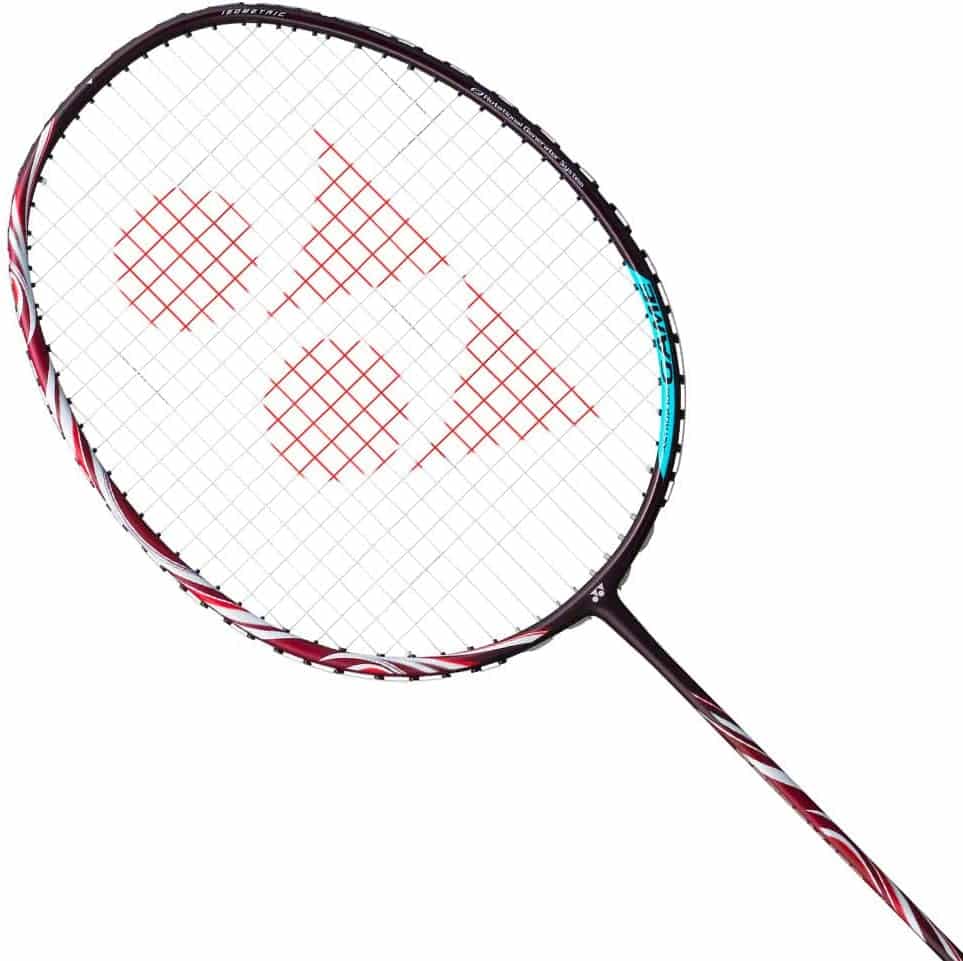
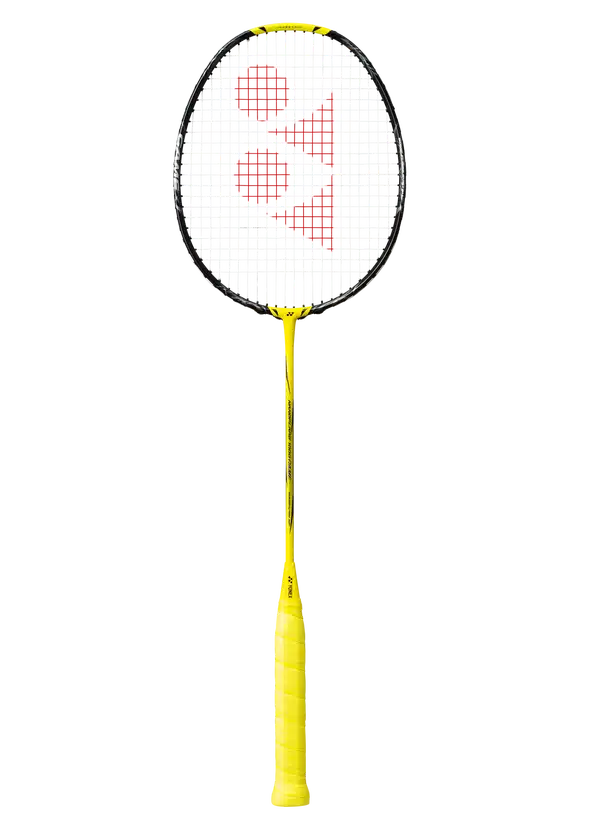
2 comments
Nice suggestion/review as always! I have question will you review nanoflare series for intermediate players? Because I find your review to be the most relatable one!
Thanks for the kind words, Taddaios. I’m working on one for the new Nanoflare 1000 Game (for intermediate players) as we speak 😉 It’ll be live in a week or two